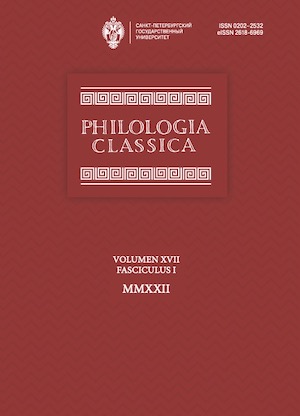ἀνά τε ἔδραμεν: Explaining the Longevity of the Tmesis
DOI:
https://doi.org/10.21638/spbu20.2022.104Аннотация
It is a well-known fact that tmesis (independent use of the preverb from its verb) as a linguistic phenomenon was progressively eliminated from Ancient Greek, so that only residual usage is attested in the language of the Classical age. However, one verb, ἀναδραμεῖν, retained tmetic usage with the particle τε intervening between the preverb and the verb, ἀνά τε ἔδραμε, until late Antiquity (Appian, Eunapius). It is significant that this construction (on par with the non tmetic form ἀνέδραμε) was used in prose, which suggests that it was part of actual linguistic usus. The article examines the reasons behind the unique longevity of this tmesis. Followingan overview of the occurrences of ἀνά τε ἔδραμεν in Herodotus, Appian and Eunapius, and the comparison of the use of the tmetic and non tmetic forms, the elements of the construction are discussed. It is shown that the survival of ἀνά τε ἔδραμεν must have been influenced by the semantic development of the verb (the root no longer denotes actual running, but springing to one’s feet or rapid growth), as well as the capacity of the preverb ἀνα- to appear independently of its verb (the deontic ἄνα). Finally, a possible shift in meaning of τε (as invariable part of the expression) is discussed. While it is impossible to pinpoint one single factor that determined the singular longevity of the tmesis ἀνά τε ἔδραμε in Greek, a combination of factors seems to have contributed to its survival.
Ключевые слова:
ἀναδραμεῖν, ἀνά τε ἔδραμε, tmesis, Homer, Herodotus, Appian, Eunapius, deontic ἄνα
Скачивания
Библиографические ссылки
Загрузки
Опубликован
Как цитировать
Выпуск
Раздел
Лицензия
Статьи журнала «Philologia Classica» находятся в открытом доступе и распространяются в соответствии с условиями Лицензионного Договора с Санкт-Петербургским государственным университетом, который бесплатно предоставляет авторам неограниченное распространение и самостоятельное архивирование.






